MARIANI’S
Virtual Gourmet
May 13, 2018
NEWSLETTER
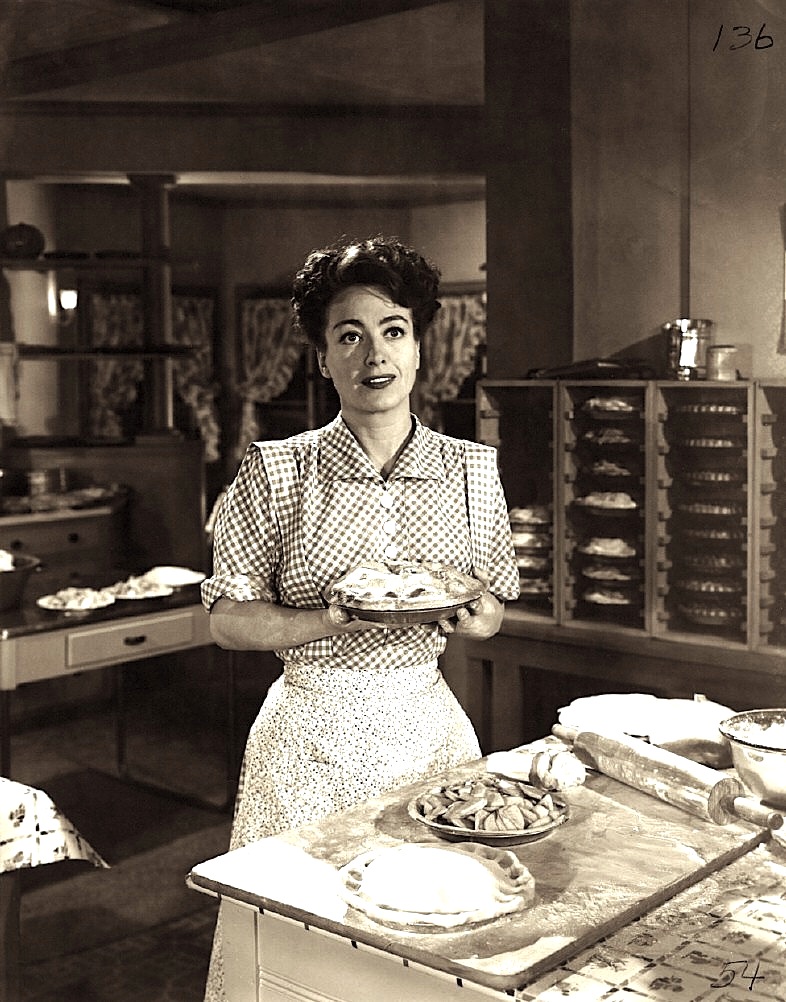
HAPPY MOTHER'S DAY!
❖❖❖
IN THIS ISSUE
IS THERE A TABLECLOTH REVIVAL?
By John Mariani
NEW YORK CORNER
NERAI
By John Mariani
NOTES FROM THE WINE CELLAR
INNOVATION MAKES FOR GREAT STRIDES
IN THE WINES OF PUGLIA
❖❖❖
IS THERE A TABLECLOTH REVIVAL?
By John Mariani

Few items in
restaurants have been so ignominiously evicted
as the white tablecloth, right along with little
lamps, pots of flowers and salad forks. To the
food media of the past decade nothing so reeks
of being “fine dining” as a table set with cloth
of any kind—linen, cotton, embossed, damask,
checkered—as if to suggest,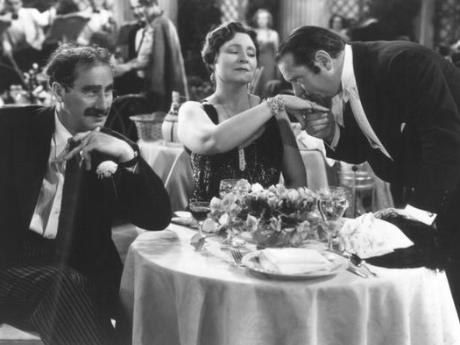 “Eat
here and be prepared to pay a fortune, be served
by pretentious waiters and be handed a menu all
in French.”
“Eat
here and be prepared to pay a fortune, be served
by pretentious waiters and be handed a menu all
in French.”
Of course, that is utter nonsense, since for the last two millennia tablecloths have been in use, both at home and in restaurants as modest as a pizzeria or Chinese eatery. Indeed, up until this century most people might have shied away from a restaurant because it did not have a tablecloth or at least, as in many bistros, a fresh paper covering, usually over a cloth. (I know of a terrific roast chicken restaurant in Berlin named Henne where one tablecloth is used throughout the evening; they simply turn it over for the next guests.)
The reasons tablecloths are so impeccably correct are many:
• They are
spanking clean and sanitary. A barely wiped bare
wooden or Formica table is a festering field for
germs.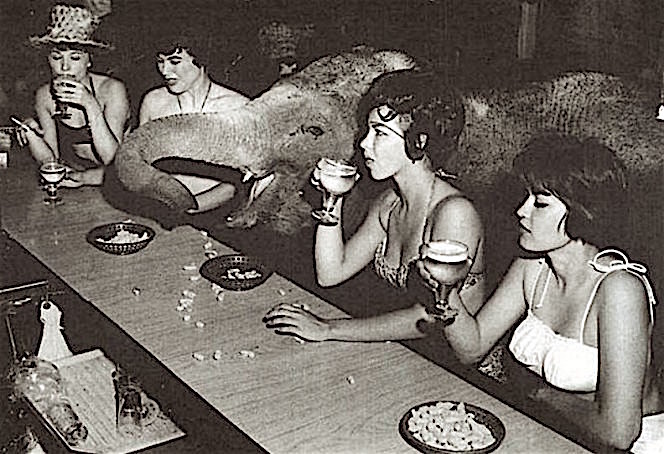
• They are soft and warm to the touch.
• They absorb spilled liquids that otherwise would spill onto your clothes.
• They reflect light, unless a restaurateur chooses a dumb color like black.
• They may provide color and add measurably to the dining room’s design, unless a restaurateur chooses a dumb color like black.
• They are easily crumbed.
• They absorb sound—not a small virtue in today’s crashingly loud restaurants.
So what’s not to like?
Ironically, the war on tablecloths began when some of the very finest of fine dining restaurants, like Jeans-Georges in New York, did away with them, insisting it was part of a “design statement,” when, in almost all cases, it was nothing more than a matter of trying to save money. And I admit that such laundry bills can mount up—tens of thousands of dollars per annum. But not using tablecloths doesn’t seem in any way to reduce the price of a meal at such restaurants. Believe me, your dinner is never cheaper because the restaurant doesn't use tablecloths.
 One of the first to rip off
tablecloths was the Judge Judy of TV food
competitions, Tom Colicchio, who upon opening
Craft in Manhattan announced it would deliberately
not use tablecloths, or any kind of “formality,”
because, he said, "I don't think people are
interested in eating like that anymore."
One of the first to rip off
tablecloths was the Judge Judy of TV food
competitions, Tom Colicchio, who upon opening
Craft in Manhattan announced it would deliberately
not use tablecloths, or any kind of “formality,”
because, he said, "I don't think people are
interested in eating like that anymore."
Of course,
colorful plastic cups, knives and forks and
patterned paper napkins might well be a design
statement too and would save them a lot more money,
but we haven't descended that low yet, except on
airplanes. Paper napkins do, however,
now seem to be far more in evidence than ever
before at the new hipster restaurants with
counters, open kitchens and excruciating house
music. 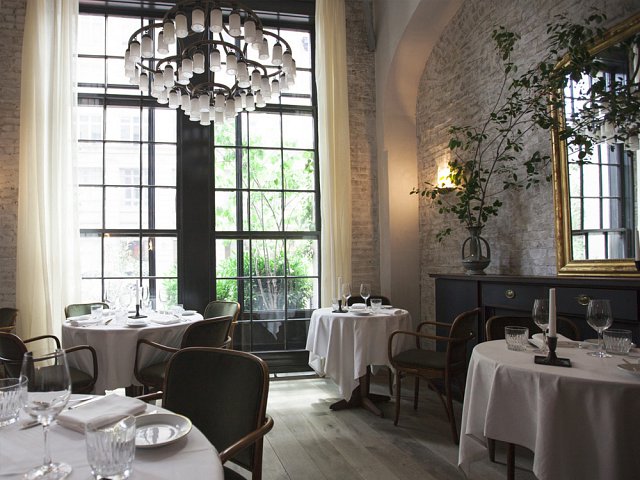
Antagonism towards napery has reached the point of banishment in most modern restaurants, however fine the dining or high the price. Consider some of the “hottest” new upscale restaurants to open in the past few months: David Chang’s new majordomo in L.A.; Chai Yo Modern Thai in Buckhead; Bellemore in Chicago; The Love in Philadelphia; and just about every hot spot in Las Vegas—all with denuded tables.
Fortunately, a happy number of both old and
new restaurants—not all of them fine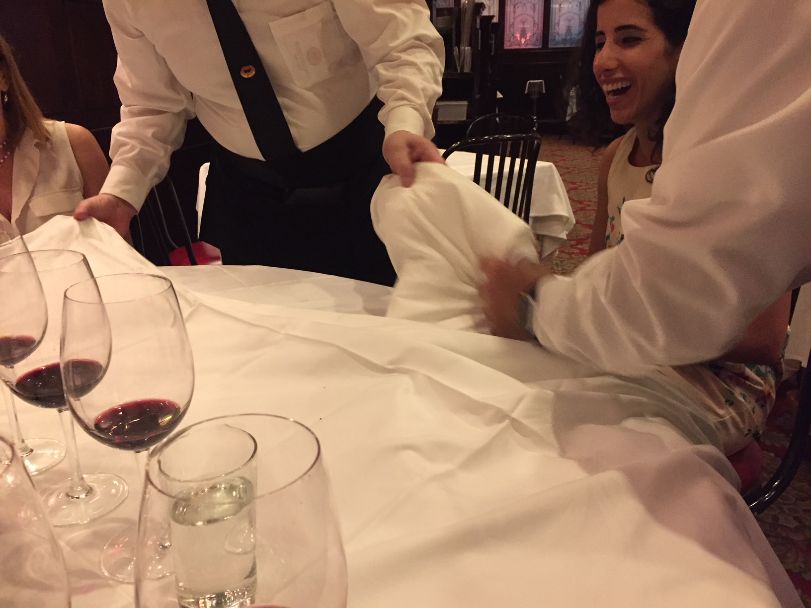 dining by a long shot—still put a
proper cloth on their tables, like Oriole in
Chicago, Mesa in Dallas, Le CouCou (right) in New
York—all packed every night.
dining by a long shot—still put a
proper cloth on their tables, like Oriole in
Chicago, Mesa in Dallas, Le CouCou (right) in New
York—all packed every night.
Of course, I will always be in awe of a cordial ritual that was once done in many restaurants in America and Europe and still one of the things that draws me back to Sparks Steakhouse in Manhattan (left). After the main course is cleared, one waiter begins to roll up the soiled tablecloth while a second waiter rolls a clean one in its place. It’s such a pleasure to watch this graceful unfolding, so that it seems that there should be no other way to set a table. There it lies before being decked out with the colors of dessert—white, lightly starched, reflecting the light. What a damn good idea a fresh tablecloth makes.
❖❖❖
By John Mariani
55 East 54th Street
212-759-5554
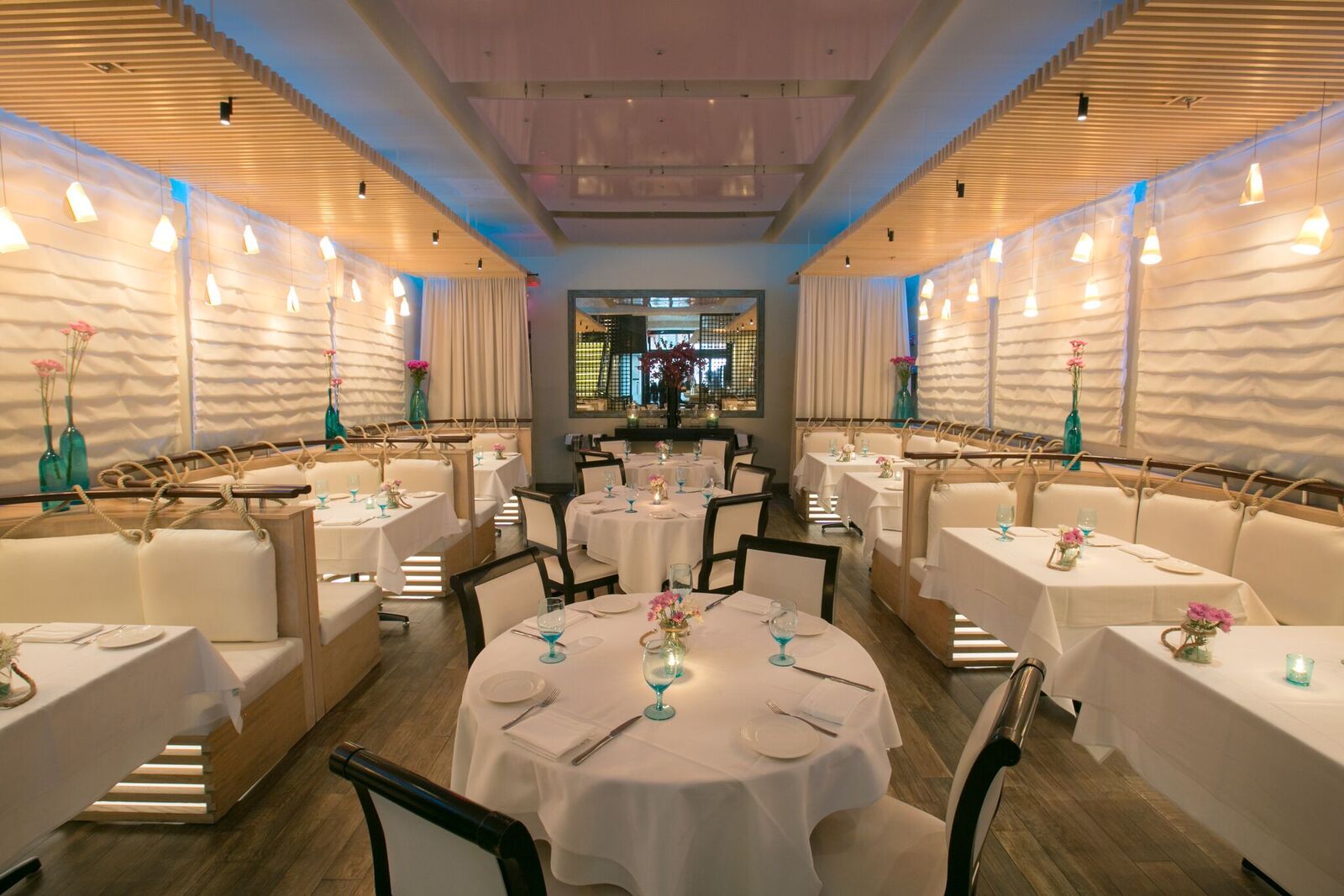
Photo by Benjamin Chasteen
When Nerai opened five years ago on the East Side, both in its décor and its cuisine rose above the city’s other high-end Greek restaurants like Milos Estiatorios and Molyvos. As I wrote at the time, “Nerai is not a taverna, no bazouki players, fish nets or faded posters of the Acropolis. Instead, Nerai is admirably at the level of a stylish Italian restaurant like Marea or a seafood restaurant like Oceana (whose premises these once were). Nerai delivers very high quality with a panache unique to Greek restaurants in NYC.”
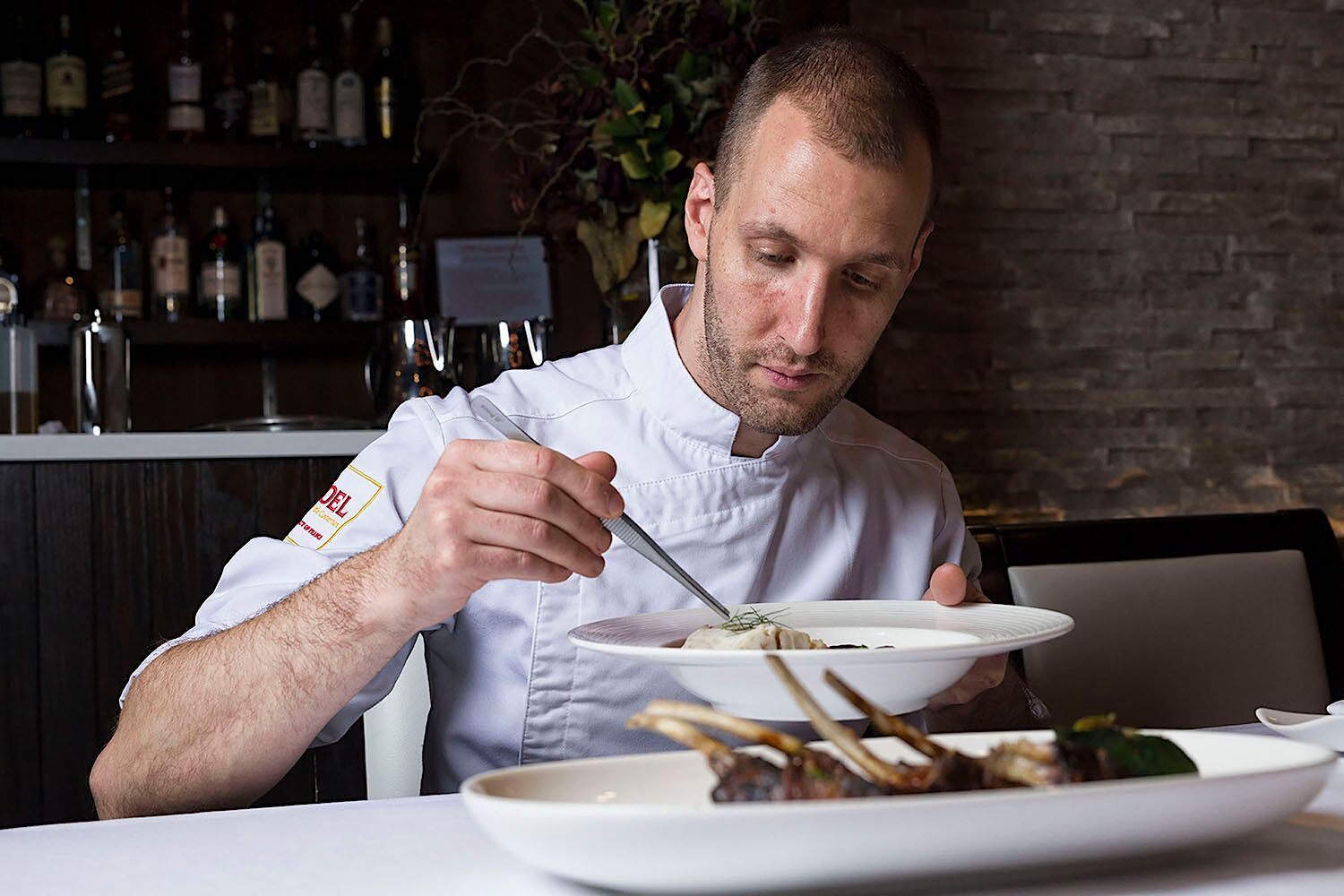 Now, under owners Spiro Menegatos, Costa Youssis and
Dinos Gourmos and a terrific young chef, the
restaurant has risen even higher by refining what
it’s always done very well, making this the finest
Greek food I’ve enjoyed in this country.
Now, under owners Spiro Menegatos, Costa Youssis and
Dinos Gourmos and a terrific young chef, the
restaurant has risen even higher by refining what
it’s always done very well, making this the finest
Greek food I’ve enjoyed in this country.
The glowing marine-like décor is exceptionally beautiful, with soft lighting playing off folds of white drapery-like fabric and fine table linens. The service staff, from the bar to the dining room, are trained in the generous spirit of what Greeks call filoxenia.
The 500-label wine list is at least 20 percent Greek, with both the newest vintages from modern wineries and some impressive older vintages going back to the 1990s, all carefully overseen by sommelier Michael Coll.
I first tasted
Israeli-born Chef Moshe Grundman’s food when he
was at a restaurant in Nyack, N.Y., where he was
doing exciting Mediterranean-style food. Before
that he’d been sous-chef at Oceana, so his way
with seafood is impeccable, including grilled
octopus (below)
served over fava beans with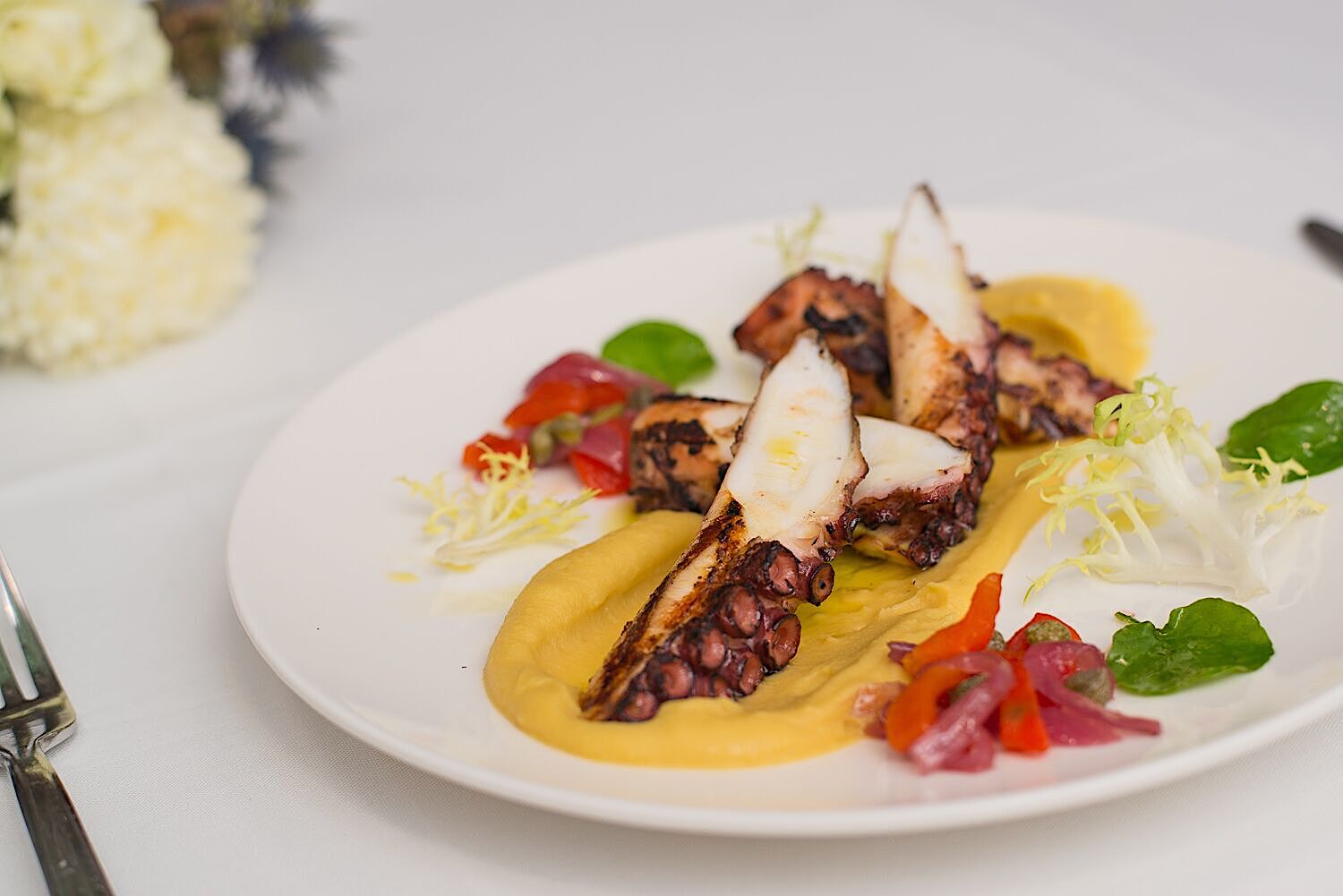 sweet
caramelized onions, roasted red peppers and capers
as an appetizer ($26).
sweet
caramelized onions, roasted red peppers and capers
as an appetizer ($26).
But the best way to begin is with a variety of spreads ($20) like revithada me hummus of braised chickpeas over tahini hummus ($14); spanakopita packets of spinach and artichokes ($15) flavored with dill and feta (the feta here is outstanding!); and kolokithakia tiganita of paper-thin piping hot zucchini chips fried to a perfect crispiness ($22).
Horiatiki ($17) takes the standard Greek tomato salad with feta, cucumber, onions, olives and treats them to a rich tomato butter that makes a big difference in flavor. The simple classic of quickly fried haloumi cheese is accompanied by sweet fresh figs and a shaved fennel salad ($16).
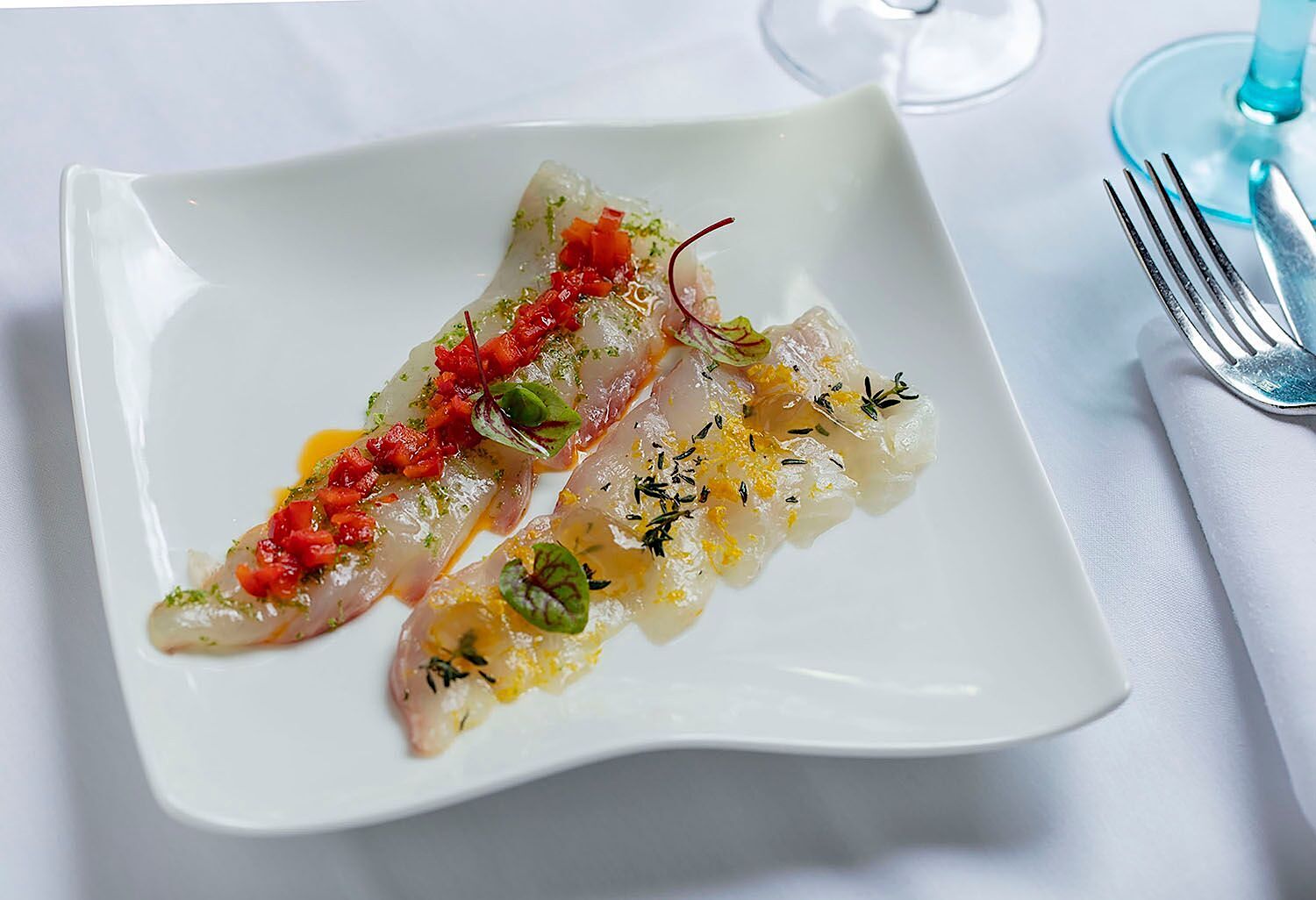 The raw
seafood dishes (left)
at Nerai show the quality of the daily choice of a
fish like dorade settled in lemon oil with a hint
of thyme and a wonderful ouzo mint gelée ($18).
The raw
seafood dishes (left)
at Nerai show the quality of the daily choice of a
fish like dorade settled in lemon oil with a hint
of thyme and a wonderful ouzo mint gelée ($18).
Pasta is now, I suppose, just as popular in Greece as anywhere else, so it was good to see Grundman (above) giving a Hellenic twist to sweet squid ink linguine in a Metaxa bisque brimming with lobster meat ($26/$39). A very Italian wild mushrooms risotto ($18/$28) incorporates porcini, cremini, beech and shiitakes, while pastitsada is a plate of slowly braised veal cheek and smoked Metsovone cheese slathered over paccheri pasta tubes ($24/$36).
I really don’t
think a Greek seafood menu of this quality needs
to list Dover sole and salmon, so go instead with
the poached kakavia
(stone bass) in a black pepper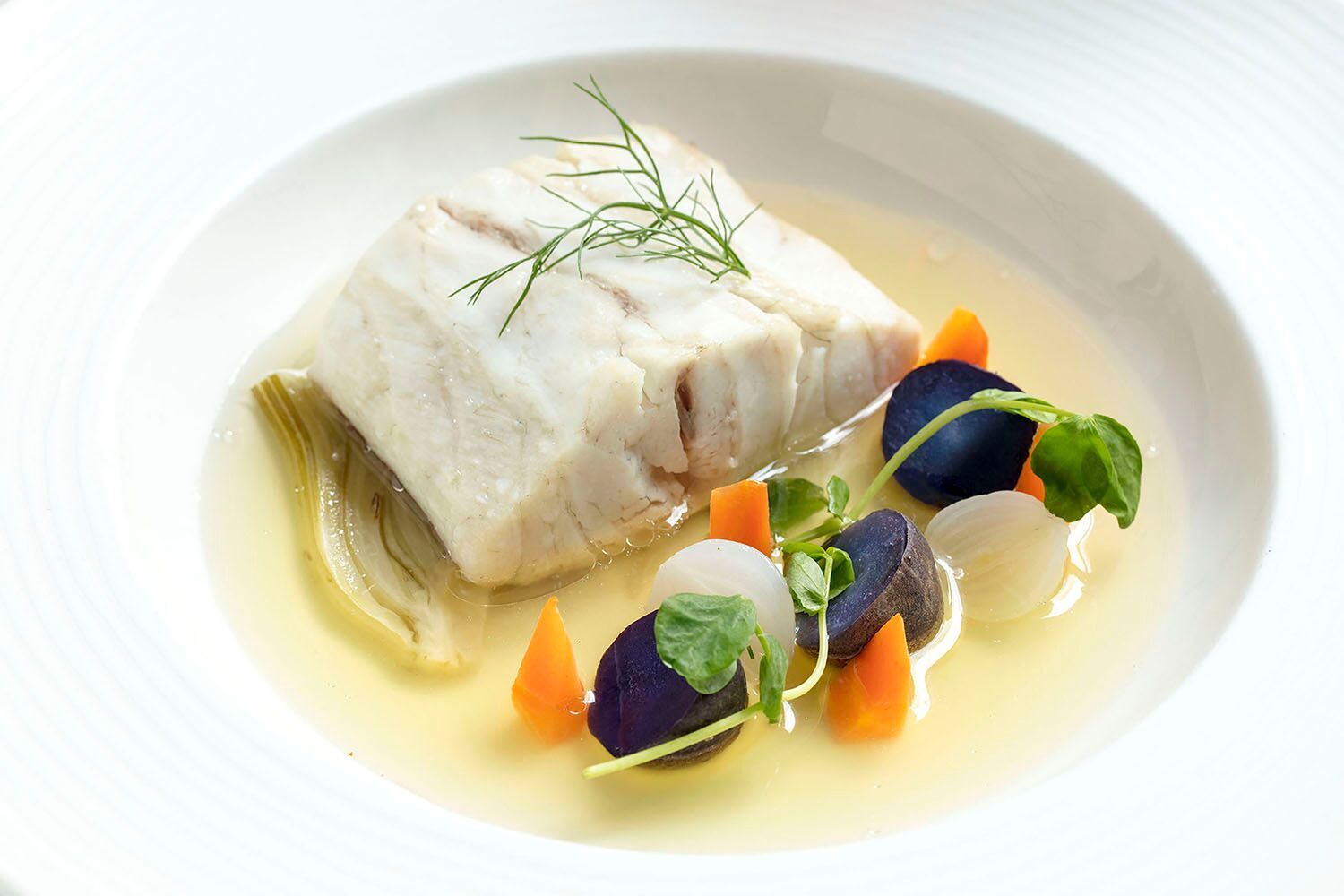 and lemon
consommé ($38), or the lavraki
of whole grilled loup de mer
dusted with fresh oregano, a lemon-olive oil
called ladolemeno
and capers ($38). Papia moussaka ($36) is a hearty
plate of duck-laced layers with lentils,
chanterelles and figs. Given Greeks’ passion for
their own lamb, I was a little surprised that
Nerai is serving Australian lamb shipped in from
10,000 miles away. It is served as chops with
honey glazed carrots, dolma and
an oregano jus ($42).
and lemon
consommé ($38), or the lavraki
of whole grilled loup de mer
dusted with fresh oregano, a lemon-olive oil
called ladolemeno
and capers ($38). Papia moussaka ($36) is a hearty
plate of duck-laced layers with lentils,
chanterelles and figs. Given Greeks’ passion for
their own lamb, I was a little surprised that
Nerai is serving Australian lamb shipped in from
10,000 miles away. It is served as chops with
honey glazed carrots, dolma and
an oregano jus ($42).
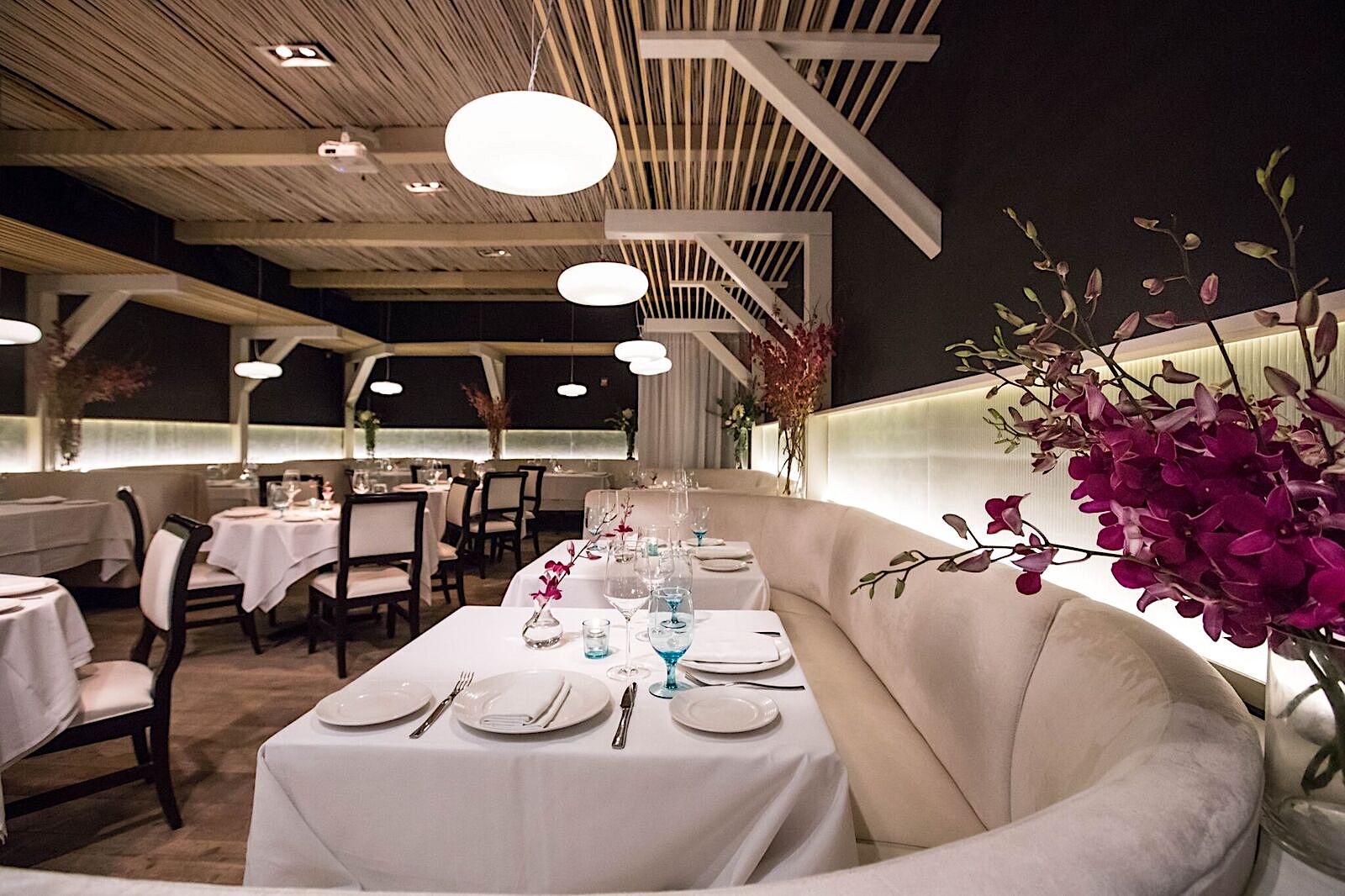 Plan
on having at least one of the fine desserts, like
the karidopita
walnut cake with milk and honey glaze and
chocolate gelato ($14), or the saragli of
freshly made baklava and tahini parfait with
sesame brittle and a pistachio gelato ($15).
Plan
on having at least one of the fine desserts, like
the karidopita
walnut cake with milk and honey glaze and
chocolate gelato ($14), or the saragli of
freshly made baklava and tahini parfait with
sesame brittle and a pistachio gelato ($15).
Nerai has debuted a 3-course weekend pre- and post-theater menu for $49 per person, a 4-course Tasting Menu for $79 and a six-course option for $115, with a wine pairing for $55. There are several unnecessary surcharges for some dishes.
I’ve said before that Greek restaurants in NYC have been largely underrated, but those like Nerai now show that they are easily in the same league as the city’s best French, Italian, Japanese and American entries. Add in a beautiful room, civilized noise level, innovative wine list and a good deal of that filoxenia, and Nerai enters the pantheon with grace.
Nerai is open for breakfast and lunch Mon.-Fri.,
for dinner Mon.-Sat.
❖❖❖
By John Mariani
IN THE WINES OF PUGLIA
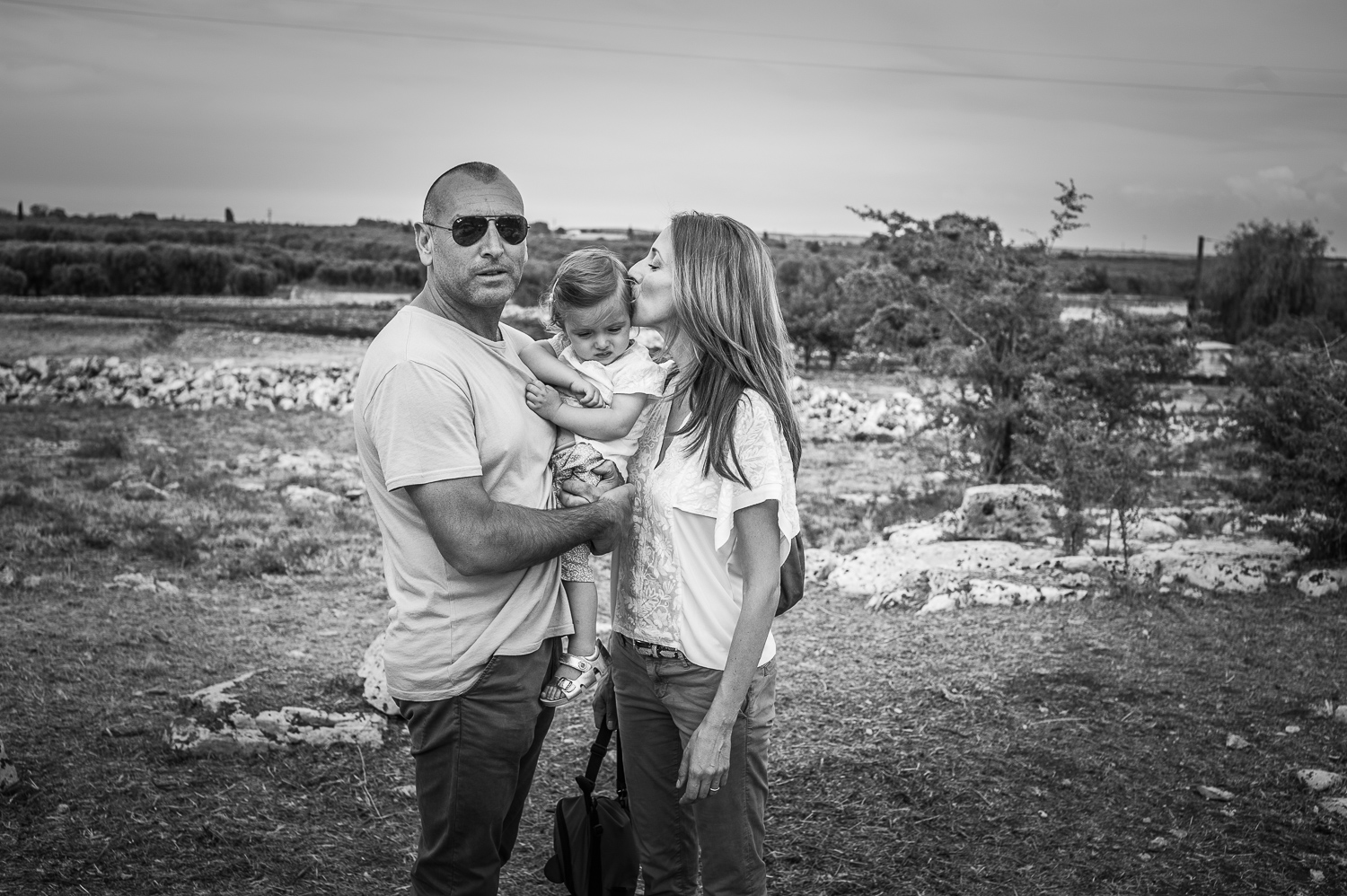
Gaetano
Marangelli and family at Cantine Menhir Salento
Read any commentary on the wines of Puglia, on the heel of Italy, and you’ll mostly find comments like “emerging wine region” and “still focused on bulk wine.” The most recent edition of the Oxford Companion to Wine sniffs that, “what Puglia urgently needs is to ensure the survival of its centenarian bush vines and most interesting indigenous varieties, and, ideally, a viticultural in winemaking institute . . . to shape its future.”
 There is some truth to
that statement, except it’s about ten years out of
date. Young vintners and new plantings in this,
the most southern of Italian wine regions, have
quickly moved to improve both the wines and their
image. Since
Puglia, Southern Italy’s wealthiest region,
produces the largest amount of the country’s
wines—17%—the impetus to produce better wines is
now paramount, despite controversial Italian wine
laws that deny producers a D.O.C. appellation if
they want to try something innovative; instead
those producers must label their wines under the
I.G.T. tag, which basically means simple table
wine.
There is some truth to
that statement, except it’s about ten years out of
date. Young vintners and new plantings in this,
the most southern of Italian wine regions, have
quickly moved to improve both the wines and their
image. Since
Puglia, Southern Italy’s wealthiest region,
produces the largest amount of the country’s
wines—17%—the impetus to produce better wines is
now paramount, despite controversial Italian wine
laws that deny producers a D.O.C. appellation if
they want to try something innovative; instead
those producers must label their wines under the
I.G.T. tag, which basically means simple table
wine.
One of the leading innovators in Puglia today,
along with wineries like Carvenea, Feudo di San
Croce, Polvanera and others, is Gaetano
Marangelli, owner and founder, in 2005, of Cantine
Menhir Salento in the southeastern part of
Salento. There
he works with traditional varietals like Primitivo
(called Zinfandel in California), Negroamaro, a
white grape called Minutolo, Ottavianello
(Cinsault in France) and the unusual Susumaniello.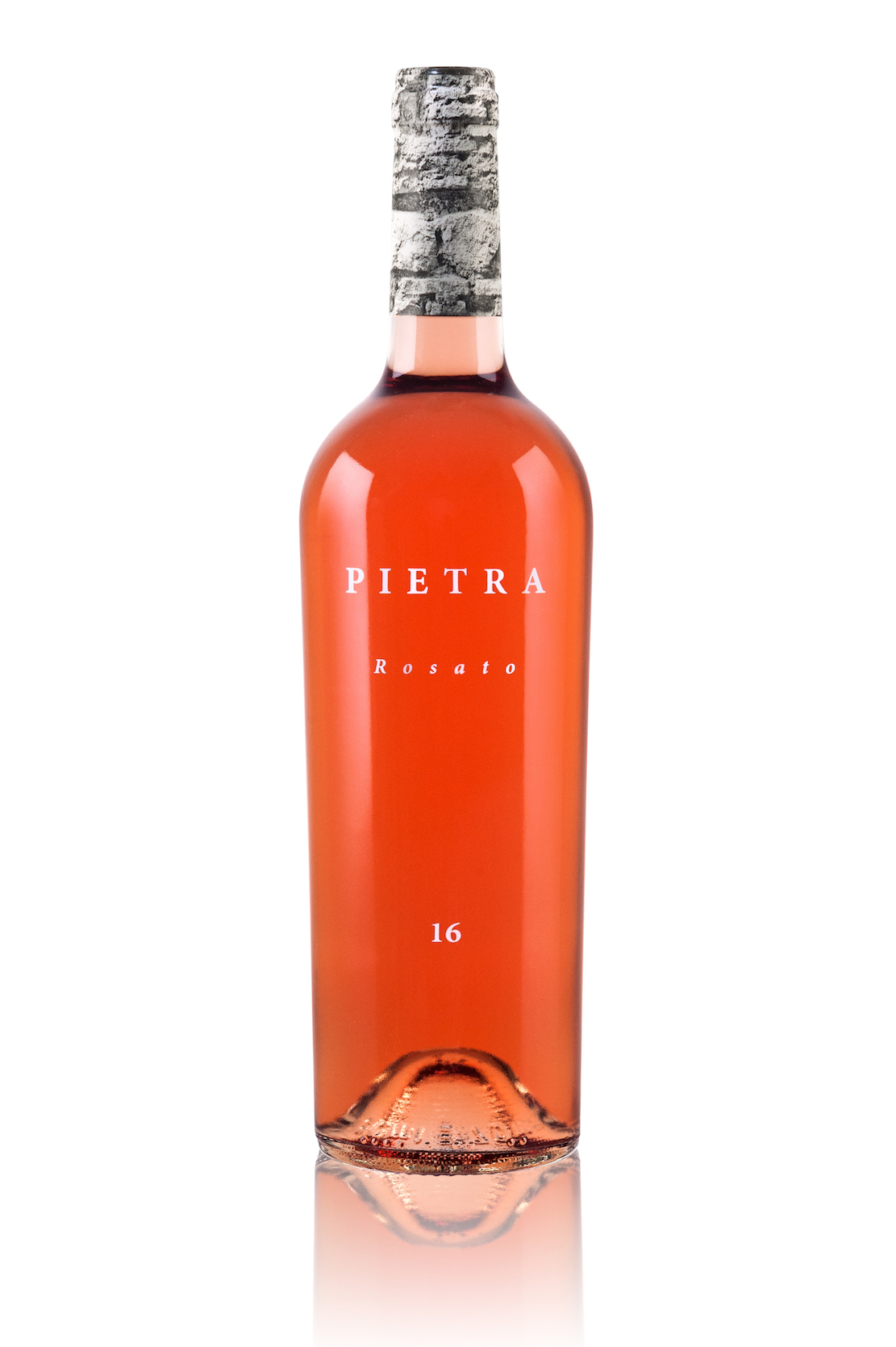
Over dinner in New York with Marangelli, I was not just impressed by the quality of the four wines he brought but by their distinctive flavors of a kind I’ve rarely encountered among Puglian bottlings. His Pietra Rosato ($15-$18) had an enchanting flowery bouquet and more body than most rosé wines, made from 85% Negroamaro and 15% Susumaniello, at 12.5% alcohol. His white wine, Pass-O ($15-$18) is 100 percent Fiano Bianco, at 14% alcohol, also expressing fragrance, a slight fruity sweetness and a refined amount of acid. This last virtue is not that easy to achieve in a very hot climate like Puglia’s.
“Our vineyards are very far east and I plant on north northeastern hillsides, which keeps the wines cooler, so that the acids develop along with the sugars,” he told me. The Sirocco winds from North Africa further help keep the intense heat at bay, and the rocky soil drains very well. Marangelli has also committed himself to being fully certified organic by 2019.
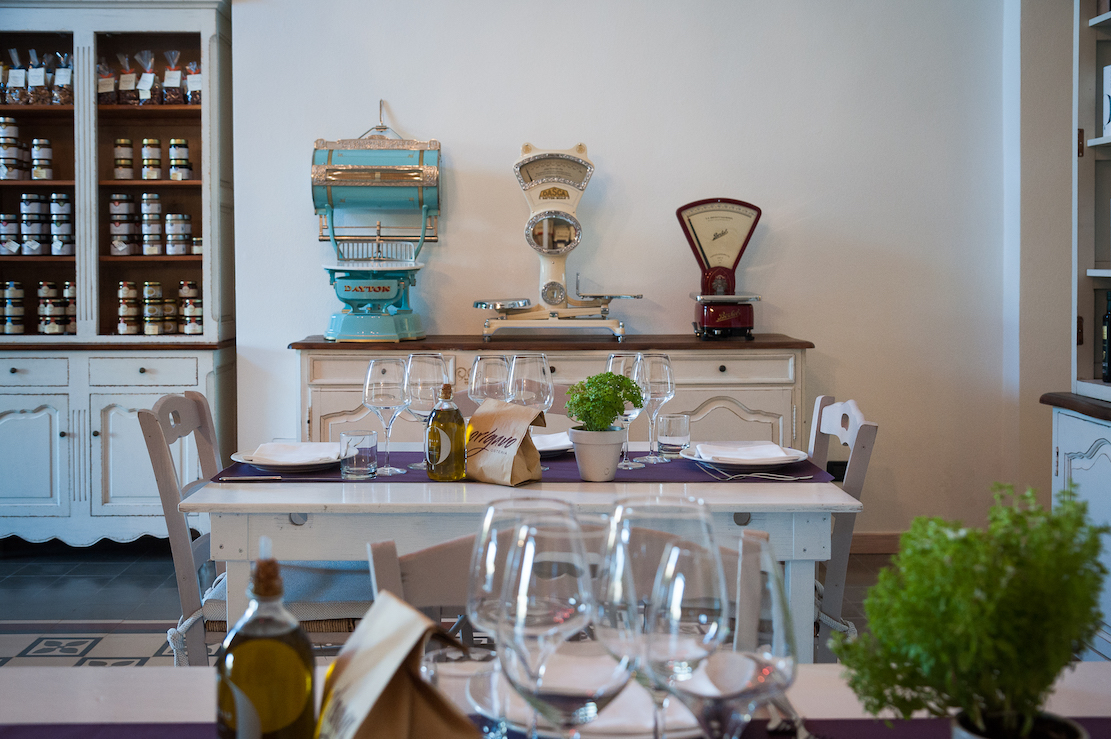 “Fifty years ago all the
wineries also produced their own olive oil,
cheese, even chickens and eggs,” he said. “I and
some of my colleagues are trying to restore that.” To such
end his property is also home to a 100-acre
organic farm named “Anna” that supplies many of
the provisions to the on-premises Origano Osteria
& Store (left),
which also has a small restaurant attached (below). He is
even in the process of building a 30-room modern
hotel, which will take advantage of Puglia’s
increasing agrotourism popularity.
“Fifty years ago all the
wineries also produced their own olive oil,
cheese, even chickens and eggs,” he said. “I and
some of my colleagues are trying to restore that.” To such
end his property is also home to a 100-acre
organic farm named “Anna” that supplies many of
the provisions to the on-premises Origano Osteria
& Store (left),
which also has a small restaurant attached (below). He is
even in the process of building a 30-room modern
hotel, which will take advantage of Puglia’s
increasing agrotourism popularity.
I tasted two of his red wines and they were
outstanding. Pietra Salice Salentino (an amazing
bargain at $15-$18) is made from 80% Negroamaro
and 20% Malvasia Nera. Thick-skinned Negroamaro,
which means “black bitter,” is a grape one wine
writer has said “leads
with bombastic fruit which makes it easy to
chug, especially alongside meatballs or pizza.” Nothing
could be further from the truth with
Marangelli’s stylish expression of the grape.
Pietra Salice Salentino has delicious levels of
flavor and only 14% alcohol. Fermented for 20
days, with 24 hours of maceration, it is aged in
Slovenian oak barriques for two years and in
bottle for four months. What
emerges is a lush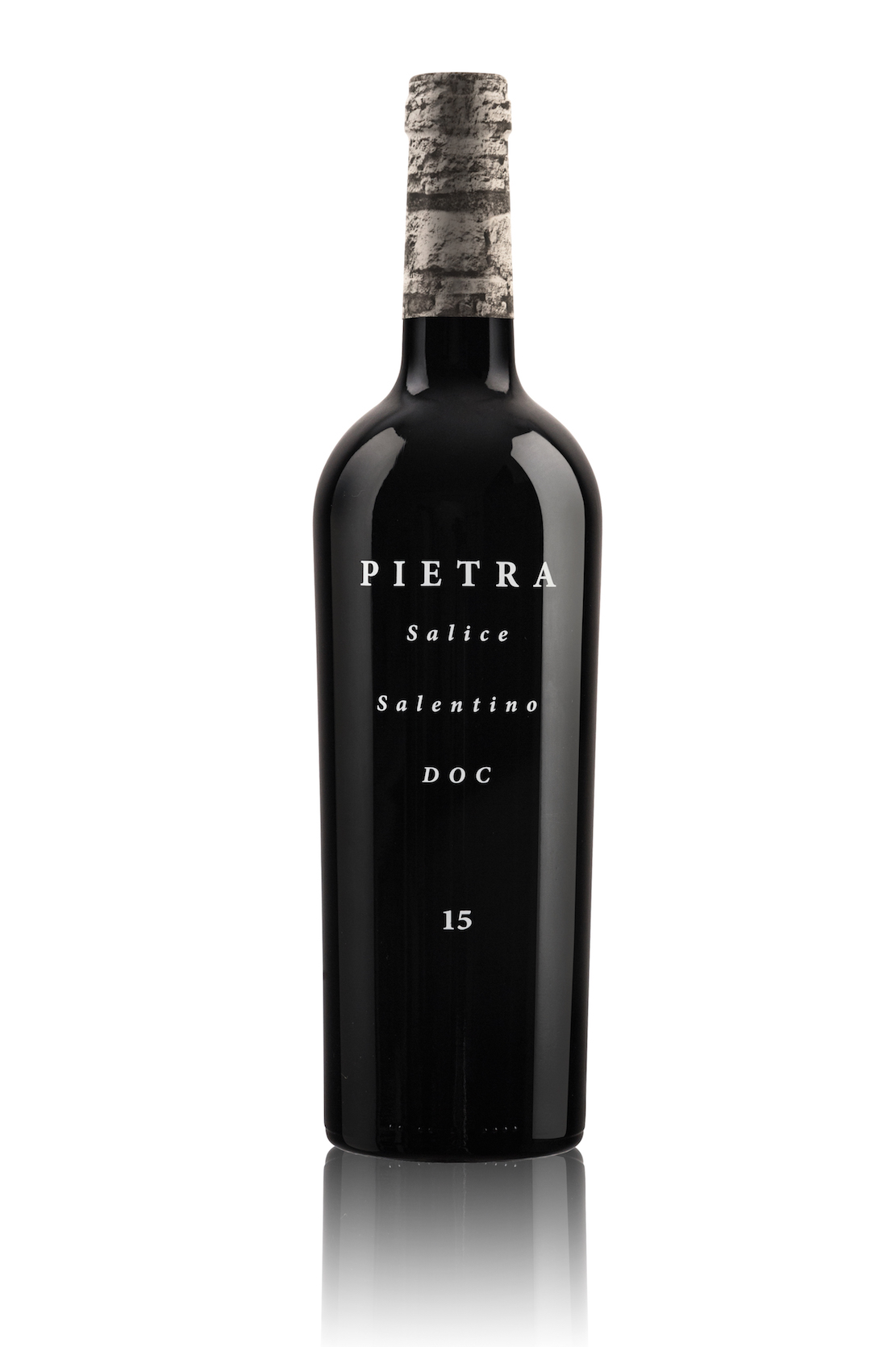 red wine
that tastes like little else outside of Puglia,
not something you chug back with meatballs and
pizza. Indeed, we enjoyed it with a steak and
mushrooms and spicy chicken alla
scarpariello with onions and chile
peppers.
red wine
that tastes like little else outside of Puglia,
not something you chug back with meatballs and
pizza. Indeed, we enjoyed it with a steak and
mushrooms and spicy chicken alla
scarpariello with onions and chile
peppers.
But his flagship wine, with only 15,000 bottles produced, is the Pietra Primitivo Susumaniello ($20-$25), which I would rank with many of the finest red wines in Italy. If there were such a class as “Super Puglians,” this would be one of them. In this case, only the Primitivo is aged and only for six months in barrique. The Susumaniello does not spend time in oak at all and is only added to the final blend before bottling and aging four months.
It is a very voluptuous wine, and that crucial acidity balances the richness of the tannins and the exuberance of the ripe fruit. By not allowing it to age in oak for an extended period, the wine maintains an elegance it might otherwise lose. At 14%, it has an ideal level of alcohol.
As do all winemakers, especially those in already hot climates, Marangelli is concerned about global warming, noting that he used to pick much of his crop in September but now picks in mid-August.
“The increase in heat creates more sugar that would become overripe by the end of September,” he says, “fermenting into too much alcohol and becoming overwhelming.”
I’m pretty sure you might enjoy Marangelli’s wines with a good pizza, but if food and wine should marry well, the food should be every bit as fine as Marangelli’s wines.
❖❖❖

THE DELECTABLE
MARCH OF SCIENCE
According to two studies
by researchers at Loma Linda U.'s School of Allied
Health Professions, eating dark chocolate can make
people smarter, as measured by EEGs to measure brain
activity after feeding five people 48 grams of 70
percent cacao.
EATING COLD CHICKEN IN A COLD
SHOWER SHOULD
BE EVEN BETTER!
"Executive chef Sean Gray, who’s also `a cold-pizza
person,' notes that piping-hot or even moderately hot
food inhibits flavor, though food scientists don’t
really know why. Another reason cold fried chicken might
be better than hot: no wait for it to cool off before
you take a bite.'"--Robin
Raisfeld and Rob Patronite, "Momofuku Ko Bar Proves Cold
Fried Chicken Can Be Just As Good As Hot," New York Magazine
(4/29/18)
Wine
Column Sponsored by Banfi Vintners
SANGIOVESE
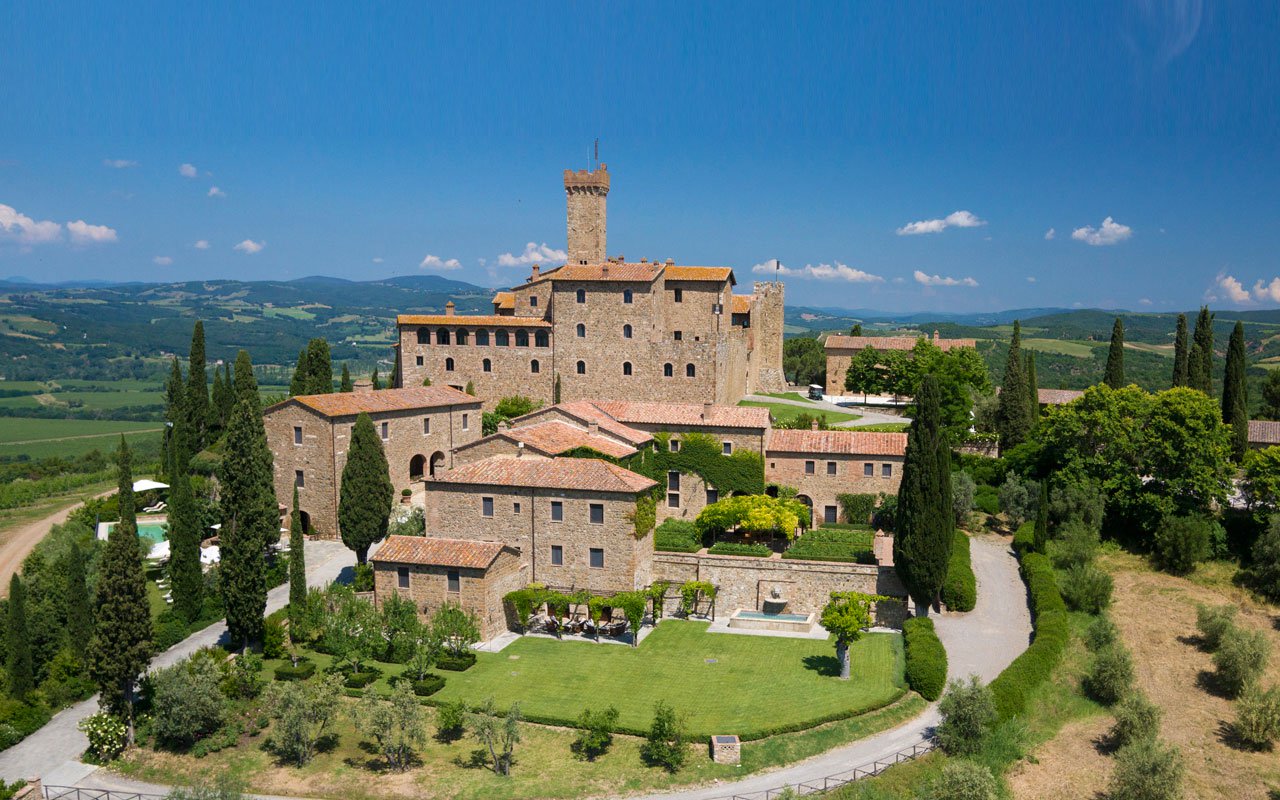 Wine is a joy year-round but
in cooler weather one
grape varietal has really taken center stage in
my daily activities – that most Italian of
grapes, Sangiovese, and its ultimate expression
– Brunello di Montalcino.
Wine is a joy year-round but
in cooler weather one
grape varietal has really taken center stage in
my daily activities – that most Italian of
grapes, Sangiovese, and its ultimate expression
– Brunello di Montalcino.
From mid-September through mid-October,
the Sangiovese grown for our various styles of red
wines are be harvested, culminating with the top
selection for Brunello di Montalcino.
Second, cooler weather here means
it is time to start enjoying more red wines and
especially Sangiovese based wines. That
includes Banfi’s cru of Brunello, Poggio alle Mura,
literally the cream of the crop of our Sangiovese
vineyards. Alongside our Poggio alle Mura Brunello di
Montalcino, this year we introduced two more wines
from the cru Poggio alle Mura – a Rosso di Montalcino
and a Riserva of Brunello. Rosso is sort of like the
younger brother of Brunello, also made from 100%
Sangiovese grapes but usually a selection from younger
vines and the wine is aged only two years compared to
the four required for Brunello. The
Riserva, on the other hand, is an even more selective
harvest of Sangiovese, and ages for an additional year
before release.
What is so special about this cru
Poggio alle Mura?
Well, it is the result our over 30 years of
ongoing research at my family’s vineyard estate,
Castello Banfi.
When we first began planting our vines there in
the late 1970s studies from the University of Bordeaux
indicated which strains of many varietals we should
plant, based on the soil type and microclimate of each
vineyard. But
when it came to the region’s native Sangiovese, there
was only local lore, no scientific research. So we took
it upon ourselves to figure out this vine, and set off
on three decades of incredibly detailed research.
We started
with 600 apparent variations on Sangiovese, because it
is so susceptible to variations in weather and soil,
and narrowed that down to 160 truly genetically
different clones.
We planted a vineyard with two rows of each
type, made wine from each of them, and charted the
differences – remember, you only get one chance a year
to make wine, so this took time.
It took about ten years to get some
concrete results, though we continue to experiment
today and always will – you never stop learning in
science and nature!
Once we determined which were the best,
complementary clones that could be planted together to
make the best Brunello, we chose to plant them in what
we determined to be the optimal vineyard sites. Coincidentally,
the best soils and climate conditions are in the
slopes surrounding the medieval fortress today known
as Castello Banfi, known since Etruscan times as
Poggio alle Mura – the walled hilltop. Hence the
name of our most special “cru” of Brunello,
representing a synthesis between tradition and
innovation.
Though the focus of this study was
our Brunello, all of our Sangiovese-based wines,
including the super Tuscans SummuS, Cum Laude, and
Centine, benefited from this work. And that’s
the third reason for celebrating Sangiovese this
month, for the range of wonderful reds that usher us
into autumn! One
wine in particular was inspired by our research – the
BelnerO, a Sangiovese dominant blend with what I like
to call a kiss of Cabernet and a whisper of Merlot. We grow the
grapes a little differently for BelnerO than for
Brunello, make the wine with less oak aging and
released it earlier from the winery, providing a
counterpoint to Brunello and a lovely terroir-driven
wine in its own right.
If you
know Italians, you know that by nature we are
multi-faceted, varying in mood, and always passionate. As a
nation, we span from the hot sunny beaches of Sicily
near the African coast to the rugged mountains and
Alpine ski slopes of Trentino-Alto Adige in the north. Sangiovese
is grown in almost all of Italy’s regions and reflects
the unique nature of each; it is most famous
(rightfully so) in Tuscany, yet even there it reflects
the nuances of each hilltop, valley and subzone. It has
something a little different to say in Brunello than
Chianti, Morellino than Vino Nobile di Montepulciano,
Rosso di Montalcino than Super Tuscan blends.
Here is a smattering of
Sangiovese-based wines that you may wish to get to
know better, reflecting a spectrum that appeals to
every occasion, every taste, and every budget. We can
assure you that the conversation will never become
boring. 
Recommendations for Celebrating
Sangiovese
BelnerO Proprietor’s Reserve Sangiovese
– A refined
cuvée of noble red grapes perfected by our pioneering
clonal research. This dark beauty, BelnerO, is
produced at our innovative winery, chosen 11
consecutive years as Italy’s Premier Vineyard Estate.
Fermented in our patented temperature controlled
French oak and aged approximately 2 additional years.
Unfiltered, and Nitrogen bottled to minimize sulfites.
Castello Banfi Brunello di Montalcino –
Rich, round, velvety and intensely
aromatic, with flavor hints of licorice, cherry, and
spices. Brunello di Montalcino possesses an intense
ruby-red color, and a depth, complexity and opulence
that is softened by an elegant, lingering aftertaste.
Unfiltered after 1998 vintage.
Castello Banfi Rosso di Montalcino – Brunello's "younger brother," produced
from select Sangiovese grapes and aged in barrique for
10 to 12 months. Deep ruby-red, elegant, vibrant,
well-balanced and stylish with a dry velvety
finish.
Poggio all’Oro Brunello di Montalcino
Riserva – A single vineyard selection of our most
historically outstanding Sangiovese, aged five years
before release, the additional year more than that
required of Brunello including 6 months in barrel and
6 months more in bottle to grant its “Riserva”
designation. Incredible
elegance and harmony. Intense with lots of fruit and
subtle wood influence. Round, complete, well balanced
with hints of chocolate and berries. Unfiltered after
1998.
Poggio alle Mura – The first tangible result of years of
intensive clonal research on Montalcino’s native
Sangiovese grape.
Estate bottled from the splendidly sun drenched
vineyards surrounding the medieval Castello from which
it takes its name.
The Brunello
di Montalcino is seductive, silky and smoky. Deep ruby
in color with an expressive bouquet of violets, fruits
and berries as well as cigar box, cedar and exotic
spices. The Rosso
di Montalcino is also intense ruby red. The bouquet
is fresh and fruity with typical varietal notes of
cherry and blackberry, enriched by more complex hints
of licorice, tobacco and hazelnut. It is full
bodied, yet with a soft structure, and a surprisingly
long finish. The Poggio alle Mura Brunello di Montalcino
Riserva is deep ruby red with garnet
reflections and a rich, ample bouquet that hints of
prune jam, coffee, cacao and a light balsamic note. It is full
and powerful, with ripe and gentle tannins that make
it velvety and harmonious; this wine is supported by a
pleasing minerality that to me speaks soundly of that
special hillside in southern Montalcino.
SummuS – A wine of towering elegance, SummuS is an
extraordinary blend of Sangiovese which contributes
body; Cabernet Sauvignon for fruit and structure; and
Syrah for elegance, character and a fruity bouquet. An elegant,
complex and harmonious red wine.
Cum Laude – A complex and elegant red which graduated
“With Honors,” characterized by aromas of juicy
berries and fresh spices.
Centine – A Cuvee that is more than half
Sangiovese, the balanced consisting of equal parts of
Cabernet Sauvignon and Merlot. Vinified in
a firm, round style that easily accompanies a wide
range of dishes, this is a smooth and fragrantly
satisfying wine with international character, and a
perennial favorite at my own dinner table.
Banfi Chianti Superiore – The “Superiore” designation signifies
stricter government regulations regarding production
and aging requirements, as compared to regular
Chianti. An
intense ruby red wine with fruit forward aromas and
floral notes. This
is a round wine with well-balanced acidity and fruit.
Banfi Chianti Classico – An enduring classic: alluring
bouquet of black fruit and violets; rich flavors of
cherry and leather; supple tannins and good acidity
for dining.
Banfi Chianti Classico Riserva – Produced from select grapes grown in the
"Classico" region of Chianti, this dry, fruity and
well-balanced red has a full bouquet reminiscent of
violets.
Fonte alla Selva Chianti Classico – This is our newest entry into the Chianti
arena, coming from a 99 acre estate in Castellina, the
heart of the Chianti Classico region. The wine is
a captivating mauve red that smells of cherry, plum
and blackberry with hints of spice. It is
round, full and balanced with very good
acidity.
Col di Sasso – Sangiovese and Cabernet Sauvignon. Luscious,
complex and soft with persistent notes of fruit and
great Italian style structure.
Any of John Mariani's books below may be ordered from amazon.com.
 The Hound in Heaven
(21st Century Lion Books) is a novella, and
for anyone who loves dogs, Christmas, romance,
inspiration, even the supernatural, I hope you'll find
this to be a treasured favorite. The story
concerns how, after a New England teacher, his wife and
their two daughters adopt a stray puppy found in their
barn in northern Maine, their lives seem full of promise.
But when tragedy strikes, their wonderful dog Lazarus and
the spirit of Christmas are the only things that may bring
his master back from the edge of despair.
The Hound in Heaven
(21st Century Lion Books) is a novella, and
for anyone who loves dogs, Christmas, romance,
inspiration, even the supernatural, I hope you'll find
this to be a treasured favorite. The story
concerns how, after a New England teacher, his wife and
their two daughters adopt a stray puppy found in their
barn in northern Maine, their lives seem full of promise.
But when tragedy strikes, their wonderful dog Lazarus and
the spirit of Christmas are the only things that may bring
his master back from the edge of despair. WATCH THE VIDEO!
“What a huge surprise turn this story took! I was completely stunned! I truly enjoyed this book and its message.” – Actress Ali MacGraw
“He had me at Page One. The amount of heart, human insight, soul searching, and deft literary strength that John Mariani pours into this airtight novella is vertigo-inducing. Perhaps ‘wow’ would be the best comment.” – James Dalessandro, author of Bohemian Heart and 1906.
“John Mariani’s Hound in Heaven starts with a well-painted portrayal of an American family, along with the requisite dog. A surprise event flips the action of the novel and captures us for a voyage leading to a hopeful and heart-warming message. A page turning, one sitting read, it’s the perfect antidote for the winter and promotion of holiday celebration.” – Ann Pearlman, author of The Christmas Cookie Club and A Gift for my Sister.
“John Mariani’s concise, achingly beautiful novella pulls a literary rabbit out of a hat – a mash-up of the cosmic and the intimate, the tragic and the heart-warming – a Christmas tale for all ages, and all faiths. Read it to your children, read it to yourself… but read it. Early and often. Highly recommended.” – Jay Bonansinga, New York Times bestselling author of Pinkerton’s War, The Sinking of The Eastland, and The Walking Dead: The Road To Woodbury.
“Amazing things happen when you open your heart to an animal. The Hound in Heaven delivers a powerful story of healing that is forged in the spiritual relationship between a man and his best friend. The book brings a message of hope that can enrich our images of family, love, and loss.” – Dr. Barbara Royal, author of The Royal Treatment.
 |
The Encyclopedia of American Food and Drink by John F. Mariani (Bloomsbury USA, $35) Modesty forbids me to praise my own new book, but let me proudly say that it is an extensive revision of the 4th edition that appeared more than a decade ago, before locavores, molecular cuisine, modernist cuisine, the Food Network and so much more, now included. Word origins have been completely updated, as have per capita consumption and production stats. Most important, for the first time since publication in the 1980s, the book includes more than 100 biographies of Americans who have changed the way we cook, eat and drink -- from Fannie Farmer and Julia Child to Robert Mondavi and Thomas Keller. "This book is amazing! It has entries for everything from `abalone' to `zwieback,' plus more than 500 recipes for classic American dishes and drinks."--Devra First, The Boston Globe. "Much needed in any kitchen library."--Bon Appetit. |
"Eating Italian will never be the same after reading John Mariani's entertaining and savory gastronomical history of the cuisine of Italy and how it won over appetites worldwide. . . . This book is such a tasteful narrative that it will literally make you hungry for Italian food and arouse your appetite for gastronomical history."--Don Oldenburg, USA Today. "Italian
restaurants--some good, some glitzy--far
outnumber their French rivals. Many of
these establishments are zestfully described
in How Italian Food Conquered the World, an
entertaining and fact-filled chronicle by
food-and-wine correspondent John F.
Mariani."--Aram Bakshian Jr., Wall Street
Journal.
"Equal parts
history, sociology, gastronomy, and just
plain fun, How Italian Food Conquered the
World tells the captivating and delicious
story of the (let's face it) everybody's
favorite cuisine with clarity, verve and
more than one surprise."--Colman Andrews,
editorial director of The Daily
Meal.com. "A fantastic and fascinating
read, covering everything from the influence
of Venice's spice trade to the impact of
Italian immigrants in America and the
evolution of alta cucina. This book will
serve as a terrific resource to anyone
interested in the real story of Italian
food."--Mary Ann Esposito, host of PBS-TV's
Ciao
Italia. "John Mariani has written the
definitive history of how Italians won their
way into our hearts, minds, and
stomachs. It's a story of pleasure over
pomp and taste over technique."--Danny Meyer,
owner of NYC restaurants Union Square
Cafe, The Modern, and Maialino.
|
 |
 |
 |
 |
 |
 |
 |
 |
 Everett Potter's Travel Report:
Everett Potter's Travel Report: 
 Eating Las Vegas
JOHN CURTAS has been covering the Las Vegas
food and restaurant scene since 1995. He is
the co-author of EATING LAS VEGAS – The 50
Essential Restaurants (as well as
the author of the Eating Las Vegas web site: www.eatinglasvegas.
He can also be seen every Friday morning as
the “resident foodie” for Wake Up With the
Wagners on KSNV TV (NBC) Channel 3 in
Las Vegas.
Eating Las Vegas
JOHN CURTAS has been covering the Las Vegas
food and restaurant scene since 1995. He is
the co-author of EATING LAS VEGAS – The 50
Essential Restaurants (as well as
the author of the Eating Las Vegas web site: www.eatinglasvegas.
He can also be seen every Friday morning as
the “resident foodie” for Wake Up With the
Wagners on KSNV TV (NBC) Channel 3 in
Las Vegas.
MARIANI'S VIRTUAL GOURMET
NEWSLETTER is published weekly. Publisher: John Mariani. Editor: Walter Bagley. Contributing Writers: Christopher Mariani,
Robert Mariani, Misha Mariani, John A. Curtas, Gerry Dawes, Geoff Kalish,
and Brian Freedman. Contributing
Photographer: Galina Dargery. Technical
Advisor: Gerry
McLoughlin.
If you wish to subscribe to this
newsletter, please click here: http://www.johnmariani.com/subscribe/index.html
© copyright John Mariani 2018

